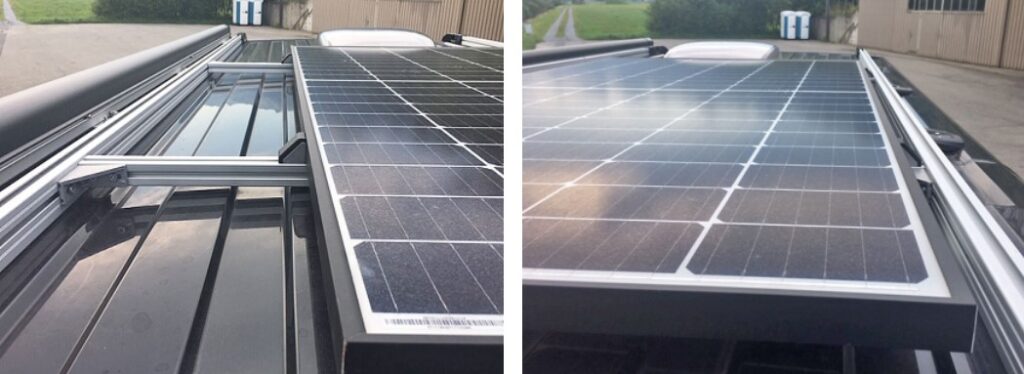Are you looking for a solution for the space-saving installation of solar panels on your camper van or do you want to make optimal use of the existing railing on your camper van? Installing a camper van solar system on the roof rack has a number of advantages and is much easier than you might think. Larger solar surfaces, better ventilation, no gluing of brackets or solar panels and more flexibility on the roof are just a few advantages of installing a solar system camper van on the roof rack. We will show you how it can be done and illustrate variants using four examples of the identically constructed “Adria Twin Supreme 640 SGX” motorhome.
Table of Contents
Mount the solar system camper van on the roof rack – a few considerations
It should be mentioned as a preliminary remark that we have not received any discounts or any other benefits from the manufacturers or companies mentioned. We have no family or personal connection with these companies. We always comment free of commercial interests and it represents our personal opinion.
Being able to stand independently for as long as possible was one of the expansion goals for our van. In addition to optimized power storage through the installation of a 200Ah lithium battery, the solar system was at the top of the list of priorities for us when it came to power generation. In order to be able to feed the 200 Ah 12v lithium ion battery with maximum power, we quickly realized that we had to operate with more than one 120-180 Wp solar panel. Distributing solar panels on the roof would have made later options such as a satellite system or a roof box impossible for us. That’s when we came up with the idea of connecting the solar system to the Thule roof rails.
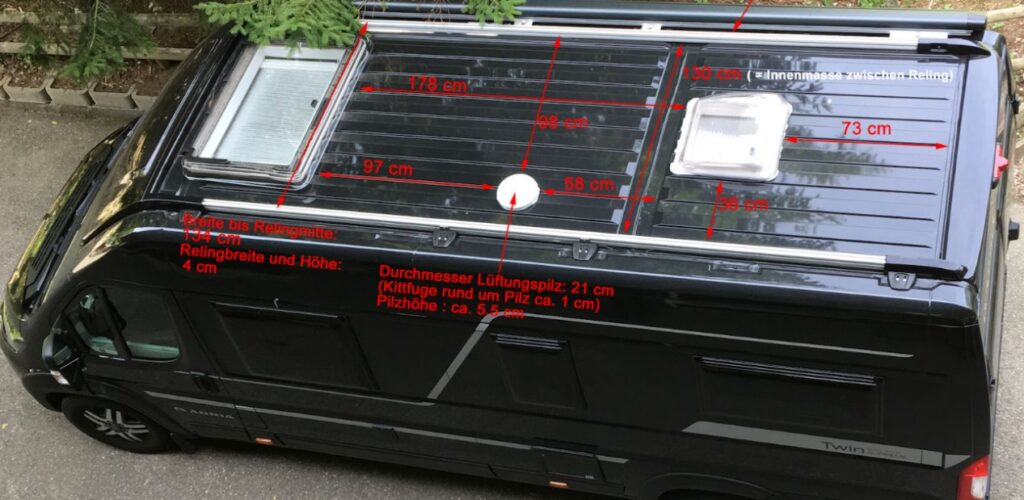
The Adria Twin Supreme campervan series already comes with a built-in Thule load carrier. However, most Fiat Ducato, Jumper and Boxer vans built after 2007 involve all the preparations on the roof so that such a Thule roof rack “SmartClamp System” can be retrofitted easily and without drilling. Similar systems are also available from other manufacturers such as Fiamma etc. The load capacity is specified as 200 kg – more than enough for attaching small solar panels.
Mount the solar system camper van on the roof rack – the advantages
When we first took measurements, we saw early on that the protruding ventilation mushroom disappears wonderfully under a solar panel when we work with cross braces between the roof rails. This gave us many more options for installing large solar panels. In our case, we could have used a continuous area 178 cm long and up to 135 cm wide.
The second advantage lies in the simple installation of camping solar panels on crossbars between the two roof rack rails. A panel is easily attached to the carrier rails with angle elements or directly with sliding blocks. There is no sticking to the roof.
Another advantage lies in the optimal ventilation of the solar panel. The air space under a panel is clearly larger than with glued mounts. At high temperatures, this brings a good performance gain. In addition, the water drainage on the roof under the panels is completely undisturbed.
As mentioned at the beginning, this allows us to keep some free space on the roof so that further extensions and attachments are still possible (SAT, roof box, spare wheel rack, etc.).
Of course, if you don’t have a rail installed on your mobile home ex works, you will be confronted with the additional costs of approx. EUR 390.00 for the roof rack. However, this can be partially offset in assembly costs or even entirely in the wider choice of solar panels.
Mount the solar system camper van on the roof rack – our shopping list
We bought the required aluminum profiles and most of the assembly material. For mounting the solar system Camper Van on the roof rack we needed the following items:
- 3 x aluminum profile 30×30 B-type groove 8 (cut to size) approx. 130 cm long (on your van, be sure to quickly measure the distance between the railings beforehand).
- 4-6 pcs. angle 30×60 B-type slot 8 with fastening set (= with sliding blocks and screws). We only fastened the middle rail with two short brackets of the type “Angle 30 B-Type Nut 8 with fastening set and cover cap”. All cross profiles could also be fastened with just the 30×60 B-type groove 8 bracket.
- Approx. 20 slot nuts heavy B-type slot 8, thread diameter M6 for mounting panel and a few spare stones.
- approx. 20 screws DIN 7984 cylinder screw with hexagon socket and low head, stainless steel A2, M6X12.
- approx. 20 stainless washers for M6 screws.
- Depending on the installation preference of the solar panel on the roof rack, the panels could also be screwed with the “Angle 30 B-Type Nut 8 with fastening kit and cover cap”. You would then need about 8 such sets per panel. However, we screwed the panel directly to the cross profiles with the screws and sliding blocks.
Everything together with shipping cost not quite EUR 69.00.
Mount solar system camper van on roof rack – shopping list solar panel / controller
For mounting the solar system camper van on the roof rack, of course we also needed solar panels, cables, roof ducts, cable ducts and solar controllers. Depending on the solar panel and installation location in the van, this list will be slightly different. Our used products:
- 1 x Q.PEAK DUO-G5 solar module monocrystalline 330Wp, to buy at greenakku.de (approx. EUR 240.00) or at www.liontron-shop.ch in Switzerland.
- 2-way cable roof duct waterproof for mobile homes, black (EUR 20.00).
- 1 x SmartSolar MPPT 100/30 solar charge controller 12/24V 30A (approx. EUR 230.00).
- 1x cartridge Sikaflex 252i black for mounting roof duct (approx. EUR 16.00).
- 2 x 6 m solar cable 6 mm2 sold by the meter black + red (total approx. EUR 30.00).
- 2 pieces MC4 connector.
- 2 x 3 m battery cables 16mm2 red + black (total approx. EUR 9.00).
- Small items such as cable fuse holders, fuses, cable ducts, insulating tape, etc. Total approx. EUR 25.00).
Mount the solar system camper van on the roof rack – the fastenings
The basis for all attachments are the two roof rack rails. The cross-section of the rail shows on the one hand the variety of attachments and on the other hand the guide cavities for the sliding blocks for screwing.
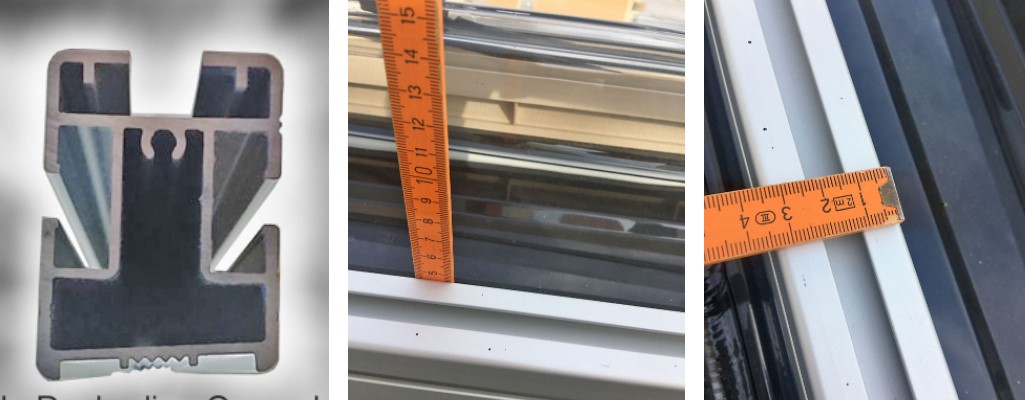
The 30 mm x 30 mm aluminum profiles used for the crossbeams leave enough leeway towards the roof (profile height of the railing approx. 47 mm) after installation so that they never touch the roof even under load and that water can flow unhindered.
For our chosen solar panel, we used 3 crossbeams, which we fastened to the front/back with four large mounting brackets and in the middle with two smaller brackets (see shopping list). We screwed the panel itself directly to the cross braces using sliding blocks. We glued a cable duct to the bottom of the panel for cable routing. We screwed another cable duct to the side of the railing and thus route the cables to the roof duct.
Finding the right sliding blocks (also called adapters) for the Thule railing is sometimes a bit of a search. As you can see in the pictures, the profile of this Thule Smart Clamp Reeling has a slit of approx. 10 mm at the top and slightly less at the sides. Since the profiles are attached to the side of the railing, either sliding blocks with a central clamping groove of 7 mm should fit (M6 or M8 screw holes) – a sliding block width of 16 – 18 mm would be good.

We also bought sliding blocks like the one in the attached picture for other projects. Maybe you also have a Hornbach or metal worker in your area and then you could slide in 2-3 different sliding blocks with the rails you bought and see that it fits for the assembly. The screws should be made of stainless material.
Install the camper van solar system on the roof rack – attach the solar panel to the cross braces
The cross braces are pre-assembled in a short time. Then place the panel provisionally to define the screw points and the exact alignment of the cross braces. Do not forget that the solar cables and the roof duct should already be prepared before installation. Depending on the type of installation selected, the panel is screwed directly onto the cross brace at the lower frame fold (our variant). We drew the support points on the side of the roof, took the crossbars off the roof again and then screwed the panel to the crossbars with a better overview on the ground. At the same time we glued a cable duct to the bottom of the panel. Then we heaved the whole construction onto the roof. We lined the whole installation with some cardboard strips so that we had the angles exactly on the lateral screwing height. Before doing this, connect the solar panel to the MC4 connectors with the solar cable and place it in the cable duct.
A very good installation variant is that the solar panel is screwed directly to the side of the cross brace with angle brackets (see variant “Installation with angle brackets”). To do this, use a file to remove the nubs on the brackets so that the brackets lie neatly on the edge of the panel and on the cross brace.
Also no worries about the ventilation mushroom for the toilet on the roof. You can simply place the panel over it if necessary. In all the cases we saw, the height of the panel frame was sufficient so that the underside of the panel didn’t touch the ventilation mushroom. You don’t have any disadvantages when you mount it like this – on the contrary, you gain a lot of flexibility in the choice of the solar panel and where / how you place the panel on the roof.
Mount solar system camper van on roof rack – solar panel and controller selection
We decided on a monocrystalline solar panel with 330 Wp, as these are unbeatable in terms of value for money. By dividing the solar cells into two circuits, the module also offers better behavior in the event of partial shading. Apart from correct performance data, the choice of the solar controller should on the one hand go well with the purchased Renogy inverter and on the other hand be able to show us the current performance data on the mobile phone via Bluetooth.
In the Adria Twin Supreme, the solar preparation would already be pre-installed at the top of the refrigerator ex works and the roof duct could be placed over it (see also our blog entry October 2019 under this link). If we had taken a slightly less powerful solar panel, then the solar cable diameter installed by Adria could have been used from the refrigerator to the Schaudt electro block. That would have meant that we had placed the Renogy solar controller under the driver’s seat as well. But just … You read our “would have” – we think that solar panels up to maybe max. 240 Wp could do justice to these cables. We found a good solar power calculators to calculate the diameter of the solar cable. We then decided on a thicker cable and the piercing at the B-pillar, since this place is very easily accessible in the front upper wall cabinet (in the direction of travel). There we only have a small wooden panel with two screws for direct access to the corner of the A and B pillars. So the solar cable comes into the vehicle right there, easily accessible, and we then pulled the cable down through the B-pillar (past the seat belt holder, etc.). From there we routed the cable first to the solar regulator under the dinette bench and from the solar regulator two cables to the on-board battery. Mounting the solar controller right under the driver’s seat would also be a good idea and would simplify the cable routing a bit. (PS: the number of cables on the solar controller is only due to the fact that we have already pre-routed the entire cable set for later installation of a Renogy Color Control GX).
Mount the solar system camper van on the roof rack – conclusion
With material costs of around EUR 650.00, we were able to install an optimal solar system with 330 Wp on our campervan. Installing a camper van solar system on the roof rack gives us a lot of freedom for later installations or for the quick replacement of the solar panel. The solar system is extremely sheltered from the wind behind the large front heki. We can see absolutely no difference in terms of wind noise.
If you want to have the thing installed by a third party, you can expect about 4-5 hours of work in the workshop to install the entire solar panel generator system.
With regard to the performance of the solar system, we have been able to gain some experience since the beginning of February 2020. It should be mentioned that we also use a 3000 watt power inverter for the coffee machine, hair dryer and charging the eBike battery and that our campervan has never been connected to shore power until October. The energy surplus of the 330 Wp panel would still allow considerable potential for charging other eBike batteries in the summer months. Unrestricted freedom on our trips in Europe would have been possible from April to September.
The power yield on shady pitches or when the sky is overcast is in the expected lower range. When the sky is evenly overcast, however, it is usually still 40-75 W. Very shady pitches and a lot of rain then drop the yield to 20-30 W. Even in autumn, when the weather is rather bad, we can be free for a good 5-6 days with our 200 Ah battery. Thanks to the additionally installed charging booster and even more free standing is possible for us.
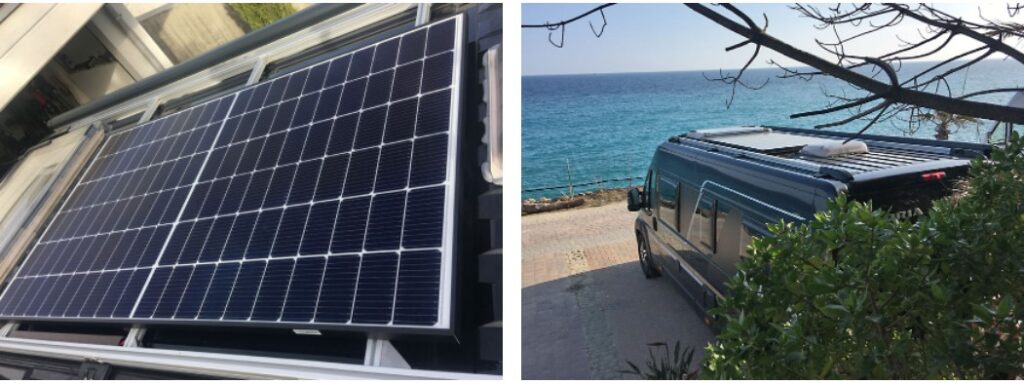
Mount the solar system camper van on the roof rack – other great variants
From conversations with our blog readers about this type of assembly, other interesting variants also emerged. Three owners of an Adria Twin Supreme 640 SGX kindly provided us with pictures of their installation of the solar system Camper Van mounted on the roof rack (many thanks to Ingolf, Max and Roger).
Mount the solar system camper van on the roof rack – variant “mounting with angle bracket”
In our opinion, a very successful way to mount the solar panel. On the one hand, the owners of this Adria Twin Supreme 640 SGX panel van installed two solar panels and used the entire width of the railing. Two solar panels can sometimes bring an advantage in partial shading. On the other hand, the assembly with angle elements is very simple and clear. If we hadn’t had to consider our built-in dome antenna on the roof, we might have chosen this solution. We also find it interesting how the owners use the rear area of the roof with another roof rack for a roof box.
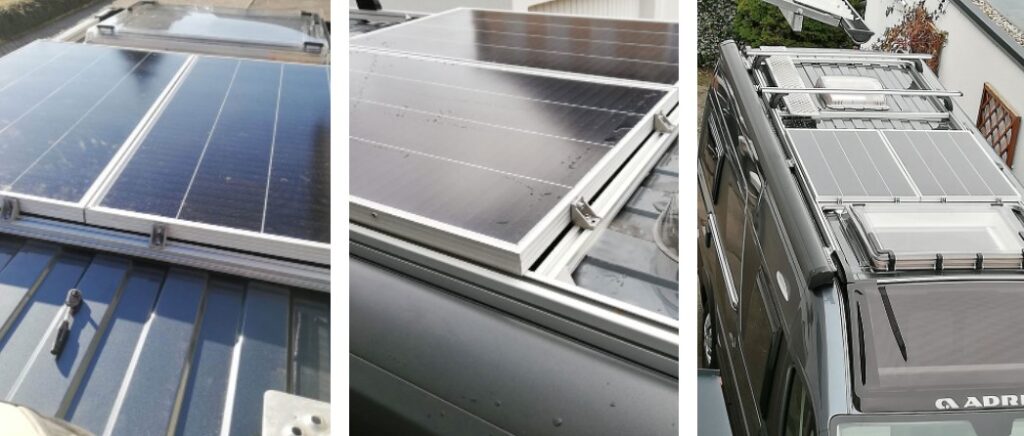
Mount the solar system camper van on the roof rack – variant “crossbar placed on railing”
The owners of this Adria Twin Supreme 640 SGX show with their variant that the roof can be used for much more than just the attachment of solar modules thanks to the railing. On the one hand, we find the laid-on and even aerodynamically shaped cross member interesting. On the other hand, two slim, long solar modules have been installed in this version. Here, too, partial shading could potentially result in advantages from two separate panels. Nevertheless, the assembly allows for an additional Thule crossbar so that the kayak and roof boxes can be arranged above it.
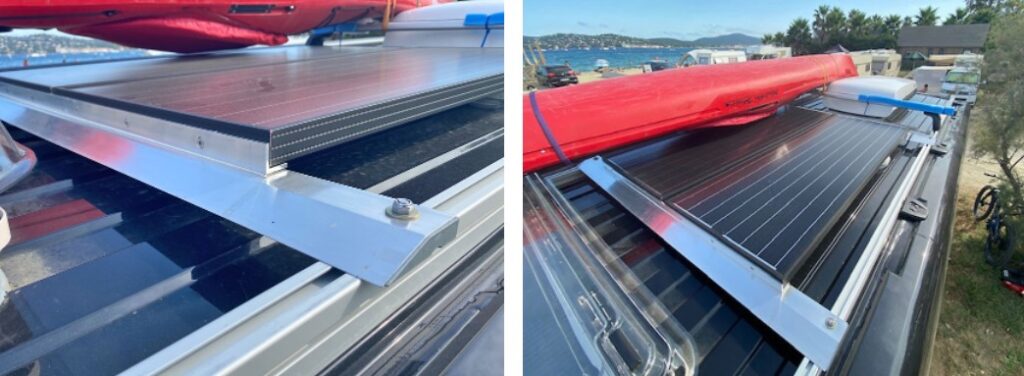
Mount the camper van solar system on the roof rack – variant “mounting with angle brackets”
At first glance, this built-in system looks the same as ours. The cross braces are also moved under the solar panel. The same solar panel “Q.PEAK Duo” was mounted here with only two cross braces. In addition, the panels are attached using lateral angle brackets. Furthermore, the owners of this Adria Twin Supreme 640 SGX moved the solar panel almost entirely to one side of the railing, leaving more space on the opposite side for more. We find this a very elegant solution and easier to assemble.
